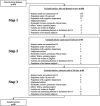Investigating psychological variables for technologies promoting physical activity
- PMID: 35923757
- PMCID: PMC9340353
- DOI: 10.1177/20552076221116559
Investigating psychological variables for technologies promoting physical activity
Abstract
Background: Many technological interventions designed to promote physical activity (PA) have limited efficacy and appear to lack important factors that could increase engagement. This may be due to a discrepancy between research conducted in this space, and software designers' and developers' use of this research to inform new digital applications.
Objectives: This study aimed to identify (1) what are the variables that act as barriers and facilitators to PA and (2) which PA variables are currently considered in the design of technologies promoting PA including psychological, physical, and personal/contextual ones which are critical in promoting PA. We emphasize psychological variables in this work because of their sparse and often simplistic integration in digital applications for PA.
Methods: We conducted two systematized reviews on PA variables, using PsycInfo and Association for Computing Machinery Digital Libraries for objectives 1 and 2.
Results: We identified 38 PA variables (mostly psychological ones) including barriers/facilitators in the literature. 17 of those variables were considered when developing digital applications for PA. Only few studies evaluate PA levels in relation to these variables. The same barriers are reported for all weight groups, though some barriers are stronger in people with obesity.
Conclusions: We identify PA variables and illustrate the lack of consideration of these in the design of PA technologies. Digital applications to promote PA may have limited efficacy if they do not address variables acting as facilitators or barriers to participation in PA, and that are important to people representing a range of body weight characteristics.
Keywords: Physical activity; barriers; behavior change; body weight; exercise; facilitators; obesity; psychology; self-care technologies.
© The Author(s) 2022.
Figures



Similar articles
-
Worksite Physical Activity Barriers and Facilitators: A Qualitative Study Based on the Transtheoretical Model of Change.Front Public Health. 2018 Nov 15;6:326. doi: 10.3389/fpubh.2018.00326. eCollection 2018. Front Public Health. 2018. PMID: 30525018 Free PMC article.
-
Do factors related to participation in physical activity change following restrictive bariatric surgery? A qualitative study.Obes Res Clin Pract. 2018 May-Jun;12(3):307-316. doi: 10.1016/j.orcp.2017.11.001. Epub 2017 Nov 14. Obes Res Clin Pract. 2018. PMID: 29150223
-
Ranking Barriers, Motivators, and Facilitators to Promote Physical Activity Participation of Persons With Dementia: An Explorative Study.J Geriatr Phys Ther. 2020 Apr/Jun;43(2):71-81. doi: 10.1519/JPT.0000000000000210. J Geriatr Phys Ther. 2020. PMID: 30095552
-
Understanding factors that influence participation in physical activity among people with a neuromusculoskeletal condition: a review of qualitative studies.Disabil Rehabil. 2016;38(1):1-10. doi: 10.3109/09638288.2014.996676. Epub 2015 Jan 14. Disabil Rehabil. 2016. PMID: 25586798 Review.
-
Barriers and facilitators to physical activity in men with prostate cancer: A qualitative and quantitative systematic review.Psychooncology. 2019 Dec;28(12):2270-2285. doi: 10.1002/pon.5240. Epub 2019 Nov 6. Psychooncology. 2019. PMID: 31617635
References
-
- WHO - World Health Organization. Spain-Fact sheet on physical activity, http://www.euro.who.int/data/assets/pdf_file/0008/382580/spain-eng.pdf?ua=1 (2018, accessed 2020 March 06).
-
- WHO - World Health Organization. Country profiles on nutrition. physical activity and obesity in the 53 WHO European Region Member States. Methodology and summary, http://www.euro.who.int/__data/assets/pdf_file/0004/243337/Summary-docum... (2013, accessed 2020 March 06). - PubMed
-
- WHO - World Health Organization, https://www.who.int/news-room/fact-sheets/detail/physical-activity (2018, accessed 2020 March 06). - PubMed
LinkOut - more resources
Full Text Sources

